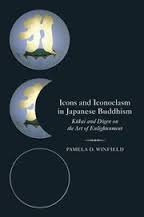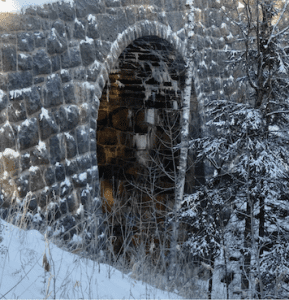 Pamela D. Winfield has undertaken a wonderfully detailed and intelligent study, Icons and Iconoclasm in Japanese Buddhism: Kukai and Dogen on the Art of Enlightenment, suitable for hopeless Dogen geeks (or Kukai geeks if there be such people) like myself and Buddhist scholars, of course, but maybe not the masses.
Pamela D. Winfield has undertaken a wonderfully detailed and intelligent study, Icons and Iconoclasm in Japanese Buddhism: Kukai and Dogen on the Art of Enlightenment, suitable for hopeless Dogen geeks (or Kukai geeks if there be such people) like myself and Buddhist scholars, of course, but maybe not the masses.
This morning, Amazon has the book at #680,626 – so, okay, for sure not the masses.
However, there is much here that informs the practice of Zen. And some that doesn’t. In this post, I’ll try to give you a little of each.
Winfield aims at answering three big questions: “Do images help or hinder the realization of Buddhahood? Does the experience of awakening involve the imagination or not? Can art ever represent the experience of enlightenment itself?”
One thing is immediately clear – Winfield is coming at this study as a Buddhist. Her questions presuppose the possibility of enlightenment as does her methodology, digging deeply into the works of two of Japan’s enlightened masters.
First a little bit about Kukai (774-835). He was a master of esoteric Buddhism and an advocate of realizing Buddhahood with this very body by just glancing at mandalas “Buddha enters me, I enter Buddha.” Winfield has a lot to say about Kukai and his elaborate practices, depictions of enlightenment, and the power of such.
Notably, someone said of Kukai, “He studied abroad [in China] to seek the Way; he went empty-handed and returned fully-equipped.”
That might sound familiar, especially to Dogenophiles.
“Not having visited many monasteries but having only studied under Master Rujing and plainly realizing that the eyes are horizontal and the nose vertical, without being deceived by anyone, I came home empty-handed,” said Dogen (1200-1253) about his own visit to China.
Turns out that Dogen’s empty-handed statement and quite a lot that he had to say was in response to Kukai, Mr. Fully Equipped.
Now it is well known that Mr. Empty Handed did indeed have a few items with him when he returned from China, including his shisho transmission certificate from Rujing (see my previous post for Katagiri Roshi on shisho). Winfield uses Dogen’s shisho as a demonstration of what she sees as Dogen’s holochronic view, time simultaneously ranging from past to present, present to past, future to present, etc.
The shisho is a blood line of succession, a dharma genealogy, that goes back to the seven primordial Buddhas. On this document, instead of lining up from past to present like most genealogies, the names are presented in a circle. That the generations are standing “…side by side and shoulder to shoulder with one another helps one to understand how their minds can transhistorically ‘see’ one another across the circle of time. It helps to explain how their minds can ‘meet’ in a momentary nikon (individual just-now being time) that is simultaneously nondual with the ranging circle of kyoryaku (dynamic range or extension of being time) holochrony” (p. 51-52).
We’re fortunate to have scholars like Winfield, Heine, Kim, Foulk, Bielefeldt, Wright, Bodiford, etc., who are helping enormously with the translation of dharma to the global culture by not only providing detailed historical analysis, contextualizing the tradition, but also developing a language for concisely presenting it. I think of Kim’s notion of “foci” and now Winfield’s “holochronic” as just a couple examples of how the fields of study and practice entangle.
Winfield also does practitioners a great service by destroying the simplistic understanding of dharma that words (and/or images) are apart from it. Kukai saw the things of world as letters constantly spelling out and preaching the dharma. Dogen said that “all buddhas are picture-buddhas and all picture-buddhas are buddhas.”
If words and images were NOT the buddhadharma, then we would have a dualistic path where silence and samadhi are privileged over expression and insight.
Despite this and other contributions, when the fields of study and practice collide, it’s usually about practicing dharma. Let me cite just one example briefly, hopefully giving you a feel for what I’m talking about.
Winfield, in pursuit of her question about art depicting enlightenment, takes up the section of Dogen’s Buddha Nature where he tells of being at a monastery in China and seeing a portrait of Nagarjuna, portrayed with a full-moon halo.
“…The body manifesting the shape of the round moon has never yet been painted,” Dogen says, demonstrating for Winfield that Dogen opposed this artistic presentation.
Winfield further quotes Dogen,
…Not to paint the body manifesting, not to paint the round moon, not to paint the full moon shape, not to trace the body of Buddhas, not to be thereby expressing, not to trace the preaching Dharma, and to trace in vain the picture of rice cake – what can possibly come of that?
For Winfield, when Dogen says “thereby expressing” he is only referring to the form of zazen as a liturgical reenactment of awakening (for more, see this series of posts). In my view, this is not correct practice enlightenment. Winfield forgets that the zazen Dogen is talking about simultaneously is not “…limited to sitting or lying down,” as Dogen expresses in the Universal Recommendations for Zazen, but is holochronically manifesting buddha.
And in not to paint the body manifesting, she also misses an application of Dogen’s “logic of ‘not.'” “Not” is not necessarily “not” as usually understood.
So what? It makes an enormous difference for practice if zazen is the only expression of enlightenment, that’s what.
Another view would be to see Dogen urging us all as Winfield quotes, “Old Buddhas! New Buddhas! Encounter the real manifesting body! Do not waste your time admiring a painted rice cake!”
How can we encounter the real manifesting body and express it in a way that is not limited to sitting or lying down?
One way is to enter the painting of Nagarjuna manifesting the round moon in the spirit of Kukai, “Buddha enters me, I enter Buddha.”
Then the don’t-tell-me-show-me koans become, “What did Nagarjuna realize such that he manifested his body of freedom like the disk of the full moon?”
And “Paint a full moon with your body.”
And “Do not waste your time admiring a painted rice cake!”











